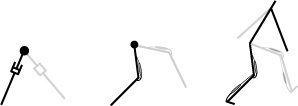Movement Lab - Press / Popular Media
 |
 |
Paper: Walking crowds on a shaky surface: Stable walkers discover Millennium Bridge oscillations with and without pedestrian synchrony, Biology Letters, 2018.
The Wall Street Journal. Swing Shift: A Bridge Wobbled and Robotics Benefited. By Jo Craven McGinty.Ars Technica. New study sheds more light on what caused Millennium Bridge to wobble. By Jennifer Ouellette.
Tech Xplore. New model offers more specifics about the swaying of the Millennium Bridge. By Bob Yirka.
Paper: Energy-optimal human walking with feedback-controlled robotic prostheses: a computational study, IEEE Transactions on Neural Systems and Rehabilitation Engineering, 26, 1773-1782, 2018.
IEEE TNSRE Featured Article. Research Highlights.EMBS Tweet. New article from TNSRE.
Paper: The metabolic cost of changing walking speeds is significant, implies lower optimal speeds for shorter distances, and increases daily energy estimates, Biology Letters, 11, 20150486, 2015. Link to article.
WebMD. For a Better Calorie Burn, Do This While Walking.CBSNews. How to burn more calories while you walk.
Huffington Post. Burn More Calories When You Walk.
Quartz. Burn extra calories every time you walk.
New York Magazine (NY Mag). Article.
Yahoo Health. Article.
Times of India. Article.
The Telegraph (UK). Altering your walking speed burns more calories than a steady pace.
People. Article.
STEAM Register. Fast, Slow, Fast, Slow.
Paper: Walking on a moving surface: energy-optimal walking motions on a shaky bridge and a shaking treadmill can reduce energy costs below normal, Proceedings of the Royal Society A, 471, 20140662, 2015. Link to article.
Gizmag. Swaying this way saves energy while walking.Ohio State. Study examines phenomenon that caused UK’s Millennium Bridge to wobble.
(PhysOrg version.)
Paper: Stepping in the direction of the fall: the next foot placement can be predicted from current upper body state in steady-state walking, Biology Letters, 10, 20140405, 2014. Link to article.
New York Times' Sunday Magazine. Finding the right balance, article by Alex HutchinsonDiscover Magazine blogs. Walking Really Is Just Falling and Catching Yourself, by Elizabeth Preston.
ABC Science Online. We're continually falling while we walk, by Anna Salleh.
Phys.Org and EurekAlert: A step in the right direction to avoid falls, by Pam Gorder.
Scientific American 60-Second Science. Audio
Paper: Sideways walking: Preferred is slow, slow is optimal, and optimal is expensive, Biology Letters, 10, 20131006, 2014. Journal link.
Irish Times. Sideways walking: it's why line dancing is good for you, by Claire O'Connell. Here's an excerpt from that article.Paper: People bouncing on trampolines: Dramatic energy transfer, a table-top Demonstration, complex dynamics and a zero sum game, PLOS ONE, 8 (11): e78645, 2013. Journal link.
Popular Science. How to win a trampoline war, according to science, by Shaunacy Ferro.Paper: Walking running and resting under time,
distance and speed constraints: Optimality of walk-run-rest
mixtures.
Leroy Long and Manoj Srinivasan. Journal of
Royal Society Interface, January 2013.
Journal link.
ScienceNOW
(Science Magazine's website): Are
we built to be lazy? By Lizzie Wade.
Wired
Magazine. By Lizzie Wade (same as above).
Runner's
World. By Scott Douglas.
National
Geographic. Why
We Walk … and Run … And Walk Again to Get Where We're Going.
By Marc Silver.
Prevention
Magazine. By Kiera Aaron.
SlashDot.
KennisLink
(Dutch).
OSU
News Release.
PhysOrg. by Pam Gorder.
EurekaAlert.
Hindustan
Times.
Spanish.
Chinese.
Italian.
Korean.
(Translations and Adaptations of above)
Saturday Night Live's Weekend Update with Seth Myers, makes a silly joke citing our study! Linked video below includes jokes that we may not officially approve of :)
Paper: Fifteen observations
on the structure of energy structure of energy-minimizing
gaits in many simple biped models.
Manoj Srinivasan. Journal of Royal Society Interface,
vol. 8, no. 54, pages 74-98, 2011.
The
Journal of Experimental Biology published a commentary by
James Usherwood in their 'Ouside JEB' section:
James Usherwood, Walk
and run to be lazy, J. Exp. Biol., vol. 213,
page iii, 2010. Full
text. PDF.
Paper: Optimal speeds for
walking and running, and walking on a moving walkway.
Manoj Srinivasan. CHAOS: An Interdisciplinary Journal for
Nonlinear Science (Focus Issue: Bipedal Locomotion --
from Robots to Humans), 19, 026112, 2009.
Daily
Princetonian
American Institute of Physics's Inside
Science
New
Scientist
The
Dialy Telegraph, UK
Related: Seth Young's interview on Radio
New Zealand (audio)
Note: Some of the popular press for this paper was somewhat misleading, unintentionally. For instance, the New Scientist article begins with the question "Say you are in a hurry to catch a flight. Should you take the moving walkway or bypass it?". My article has exactly nothing to say about this question. My article only discusses the possible behavior of people not in a hurry. On the other hand, Seth Young's Ph.D. thesis addresses some effects of congestion on moving walkways, and might be relevant in this context.
Paper: Computer optimization
of a minimal biped model discovers walking and running.
Manoj Srinivasan & Andy Ruina. Nature. Vol 439,
Pages 72-75, 2006.
News and Views articles in Journals
Optimizing walking and running. by Tytell E, Journal of Experimental Biology. 209 (7), 2006
Video/Television
American Institute of Physics,
video by Ivanhoe Broadcasting - Webpage
with video (see video below, right)
Discovery Channel - Jay's
Journal (see video below, left) on Daily Planet. Video
credit: Jay Ingram.
National Geographic Channel - Mad Labs (Manoj has a copy of
the episode)
Radio
Imagine that! NSF's science news segment on NPR - mp3 file
Internet/Paper (a selection)
New Scientist - webpage, excerpt
Science News Science Now - webpage, article
Nature Online webpage
NSF press release - webpage with video, pdf
GEO.de (in german) html
article
Physorg.com html
article
Medical News Today html
article
... and syndicated distributions thereof. Eventually these links will fade away, like many things on the internet. Some already have.
Paper: Idealized walking and running gaits
minimize work.
Manoj Srinivasan & Andy Ruina. Proceedings of the
Royal Society: Series A. Volume 463, pages 2429-2446,
2007
Telegraph, UK
Associated Press
Disovery
Channel website
In
the News
